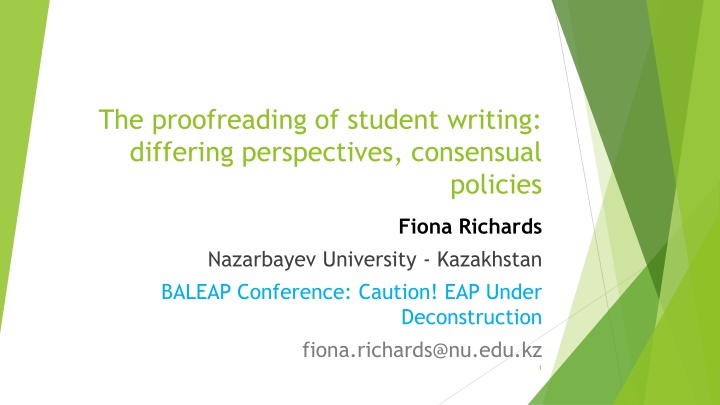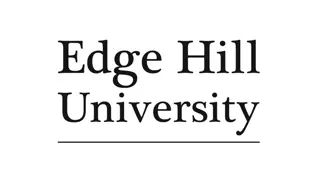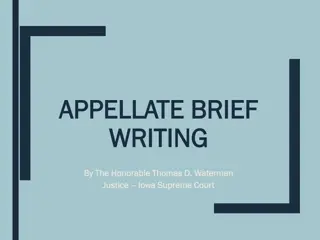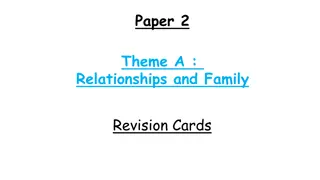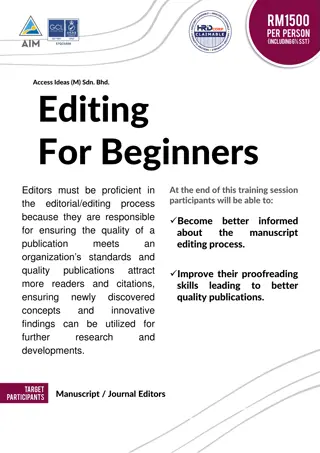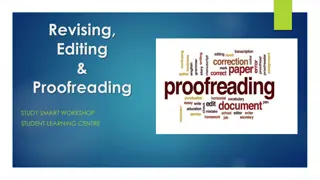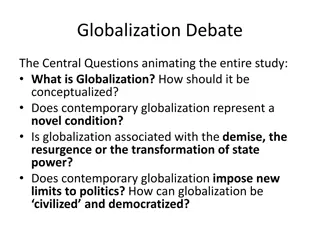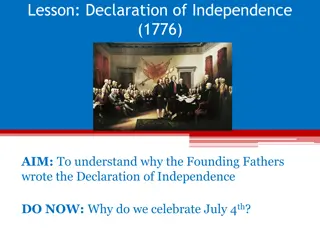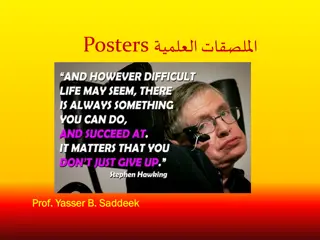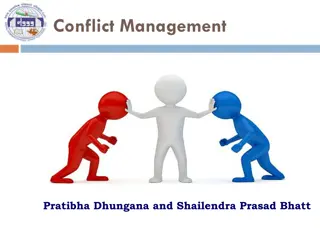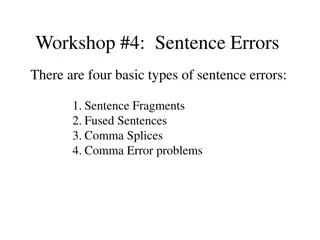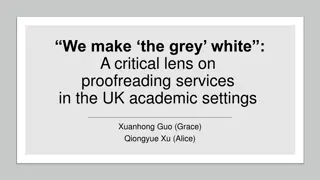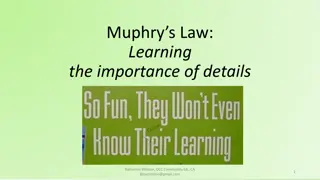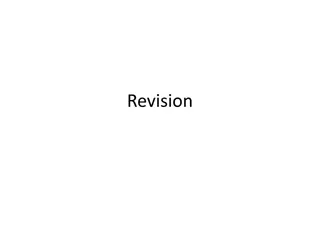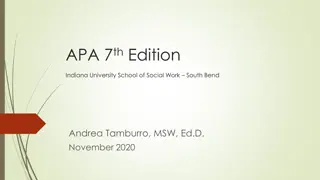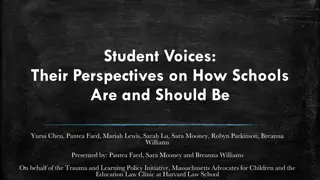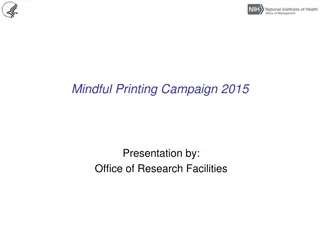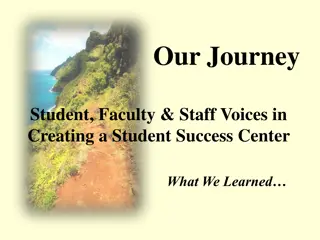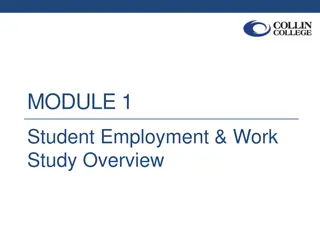Differing Perspectives on Student Proofreading
Proofreading practices at a UK university from the viewpoints of L2 students, proofreaders, and lecturers. The study delves into ethical considerations and interventions in student writing, using a mixed-methods research approach.
Download Presentation

Please find below an Image/Link to download the presentation.
The content on the website is provided AS IS for your information and personal use only. It may not be sold, licensed, or shared on other websites without obtaining consent from the author.If you encounter any issues during the download, it is possible that the publisher has removed the file from their server.
You are allowed to download the files provided on this website for personal or commercial use, subject to the condition that they are used lawfully. All files are the property of their respective owners.
The content on the website is provided AS IS for your information and personal use only. It may not be sold, licensed, or shared on other websites without obtaining consent from the author.
E N D
Presentation Transcript
The proofreading of student writing: differing perspectives, consensual policies Fiona Richards Nazarbayev University - Kazakhstan BALEAP Conference: Caution! EAP Under Deconstruction fiona.richards@nu.edu.kz 1
Structure of talk PhD pilot and main study research (Richards, 2022) 1. Research design: title, questions, mixed-methods, participants 2. Example interventions of proofreader changes 3. Findings Quantitative and qualitative 4. Stakeholder tool for academics when permitting the proofreading of student work for assessment 2
Research Title & Questions Title: An investigation into proofreading practices at a UK university: the perspectives of an L2 student, proofreader, and lecturers Overarching research question: How do students, proofreaders, and lecturers perceive a range of proofreader interventions in terms of ethical appropriacy? 3
Research Method Approach Used mixed methods: Quantitative analysed proofreading interventions made to student participants work i.e., what changes the proofreader made and how many changes through a taxonomy based on Harwood (2018) and Kruger frameworks and Bevan-Dye s (2010) Qualitative discussed at interview changes that were and were not made to the student texts to investigate views on lighter and heavier touch interventions 4
Participants All participants were based at the same UK university Pilot study: An L1 Chinese-speaking student studying toward an MA in Applied Linguistics and TESOL An L1 Spanish-speaking lecturer and an L1 English- speaker lecturer working in the Department of English Language and Linguistics 5
Participants Main study: An L1 Spanish-speaking student studying toward a Doctorate in Education An L1 English-speaking professional proofreader who proofread the student s work without payment as they are friends. Two L1 English-speaking senior lecturers from: 1) Department of Linguistics; and 2) Department of Urban Studies and Planning retired and proofread student work for assessment English Language and 6
Quantitative Analysis - Example Interventions Intervention categories included: Adding or deleting words Substitution Reordering words, phrases, or sentences Rewriting Recombining Mechanical alteration Structural editing Meaning and content 7
Quantitative Findings (1) Overall number of interventions Pilot MA text - 219 to 2,657 words (8.24 interventions/100 words) Main study EdD chapters/thesis 5,577 to 124,341 words (4.48 interventions/100 words) In-text and comment interventions Pilot MA text 215 in-text changes and 4 comments Main study EdD chapters/thesis 4,574 (3.67/100 words) in-text changes, and 1003 (0.80/100 words) comments 8
Quantitative Findings (2) Most interventions were lighter-touch Pilot MA text Substitution (82, 3.08/100 words) Addition and mechanical alteration (47, 1.76/100 words) Main Study EdD chapters/thesis Mechanical alteration (2931, 2.35/100 words) Reference list (1133, 0.91/100 words) Substitution (842, 0.67/100 words) 9
Quantitative Findings (3) Minimal/no intervention Recombining - Pilot (7)/Main study (1) Reordering Pilot (3)/Main study (41) Rewriting Pilot (1)/Main study (13) Meaning and Content Pilot (no changes)/Main study (1) 10
Qualitative Findings Consensus(1) Acceptable interventions Pilot MA Text 1. Addition and deletion 2. Mechanical alteration 3. Reordering 4. Recombining Main Study EdD chapters/thesis 1. Minor addition 2. Mechanical alteration 3. Reordering words within a sentence 4. Substitution 11
Qualitative Findings Consensus (2) Questionable/unacceptable interventions Pilot MA text 1. Adding a year to a citation 2. Rewriting Main Study EdD Chapters/Thesis 1. Deletion 2. Meaning 3. Structure Comments preferred over in-text changes for both studies Comments preferred over in-text changes (cf. Harwood, 2019; Kruger and Bevan-Dye, 2010) to ensure proofreading is educative (cf. Harwood, 2022) 12
Qualitative Findings Disagreements Pilot Study Student had a more permissive view of proofreading than lecturers but opinions diverged between the latter regarding number of overall changes (cf. Harwood, 2023) Main Study Student was more discerning than the pilot and general consensus as to un/ethical proofreading but some disagreements e.g., rewriting, and meaning and content 13
Stakeholder tool Findings led to development of a stakeholder tool (Richards, in preparation) Limits placed on proofreaders by academics are formative Stakeholder tool shows potentially acceptable, unacceptable forms of proofreading intervention three questionable, categories of and 14
Example Intervention Minor Addition Minor addition involves the proofreader adding one to five words to a student s text. 1) Adding the words flexibleenvironment in the first example is acceptable as it had already been referred to earlier by the student. 2) Adding providing/strengthening in the second is even more appropriate as it is a suggestion rather than a direct change by the proofreader. The proofreader s intervention The student s original text Thus, while the first FL principle, flexible environment, may be closely linked to social constructivism, the second FL principle could be connected with a broader understanding of constructivism. (in-text) 1. Thus, while the first FL principle may be closely linked to social constructivism, the second FL principle could be connected with a broader understanding of constructivism. 1. 2. Ridley (2012) further explains how this also influences the formulation of RQ as well as the justification for researching this topic. 2. The providing/strengthening the justification for researching a chosen topic ? (comment) proofreader suggested as well as Does the supervisor approve of the proofreader making minor addition interventions? Yes No Reason: _________________________________ 15
Stakeholder Agreement Permitting Proofreading Stakeholder Agreement Permitting Proofreading document tool feeds into a Stakeholder Document is based on that of the Society of English- language Professionals in the Netherlands (SENSE) (SENSE, 2016) 16
Implementation of Stakeholder Tool Needs much organisation (Salter-Dvorak, 2019) and difficult to establish (Harwood, 2023) Stakeholder tool is designed to advise academics as to un/ethical forms of proofreading, allowing them to make informed decisions concerning suitable forms of third-party intervention Important to educate staff and students (Bretag and Mahmud (2016, pp. 468-469) Core of stakeholder tool is ethically appropriate forms of proofreading and communication amongst stakeholders (see Alhojailan, 2019; Harwood 2018, 2019; Harwood et al. 2009, 2010, 2012; Kim, 2019; Kim and LaBianca, 2018; McNally and Kooyman, 2017) 17
References Alhojailan, A.I. (2019). Changes Beyond Limits: Proofreading in an American University. International Journal of Linguistics, 11(5), 169-180 https://doi.org/10.5296/ijl.v11i5.15280 Bretag, T., & Mahmud, S. (2016). A Conceptual Framework for Implementing Exemplary Academic Integrity Policy in Australian Higher Education. In T. Bretag (Ed.), Handbook of Academic Integrity. (pp. 464-480). Springer Reference. https://doi.org/10.1007/978-981-287-098-8_24 Harwood, N. (2018) What do proofreaders of student writing do to a master s essay? Differing interventions, worrying findings , Written Communication, 35(4), 474-530. https://doi.org/10.1177/0741088318786236 Harwood, N. (2019). I Have to Hold Myself Back from Getting into All That : Investigating Ethical Issues Associated with the Proofreading of Student Writing. Journal of Academic Ethics, 17, 17-49. https://doi.org/10.1007/s10805-018-9322-5 Harwood, N. (2022). Teaching the writer to fish so they can fish for the rest of their lives : lecturer, English language tutors, and student views on the educative role of proofreading. English for Specific Purposes, 68, 116-130. https://doi.org/10.1016/j.esp.2022.07.002 18
References Harwood, N. (2023). Lecturer, language tutor, and student perspectives on the ethics of the proofreading of student writing. Written Communication, 40(2), 1-69. https://doi.org/10.1177/07410883221146776 Harwood, N., Austin, L., & Macaulay, R. (2009). Proofreading in a UK university: Proofreaders beliefs, practices, and experiences. Journal of Second Language Writing,18(3), 166 190. https://doi.org/10.1016/j.jslw.2009.05.002 Harwood, N., L. Austin, and R. Macaulay. (2010) Ethics and integrity in proofreading: Findings from an interview-based study , English for Specific Purposes, 29(1), 54-67. https://doi.org/10.1016/j.esp.2009.08.004 Harwood, N., L. Austin, and R. Macaulay. (2012) Cleaner, helper, teacher? The role of proofreaders of student writing , Studies in Higher Education, 37(5), https://doi.org/10.1080/03075079.2010.531462 Kim, E-Y.J. (2019). Korean scholars Use of For-Pay Editors and Perception of Ethicality. Publications. 7(1), 1-12. https://doi.org/10.3390/publications7010021 Kim, E-Y. J., & LaBianca, A. S. (2018). Ethics in Academic Writing Help for International Students in Higher Education: perceptions of Faculty and Students. Journal of Academic Ethics, 16, 39-59. https://doi.org/10.1007/s10805-017-9299-5 569-584. 19
References Kruger, H., and A. Bevan-Dye. (2010) Guidelines for the editing of dissertations theses: A survey of editors perceptions , Southern African Linguistics and Applied Language Studies, 28(2), 153-169 https://doi.org/10.2989/16073614.2010.519110 and McNally, D, & Kooyman, B. (2017). Drawing the line: Views from academic staff skills advisors on acceptable proofreading with low proficiency writers. Journal of Academic Language & Learning, 11(1), A145- A158. and Richards, F. (2022). An investigation into proofreading practices at a UK university: The perspectives of an L2 student, proofreader, and lecturers [Unpublished PhD thesis, University of Sheffield]. https://etheses.whiterose.ac.uk/31203/ Richards, F. (in preparation). Proofreading student writing: a research-based stakeholder tool Targeted journal: Journal of Academic Ethics Salter-Dvorak, H. (2019). Proofreading: How de facto language policies create social inequality for L2 master s students in UK universities. Journal of English for Academic Purposes, 39, 119-131. https://doi.org/10.1016/j.jeap.2019.03.004 SENSE (2016). Guidelines for Proofreading Student Texts. SENSE Guidelines for Proofreading Student Texts (August 2016) - sense-online.nl 20
Thank you! 21
